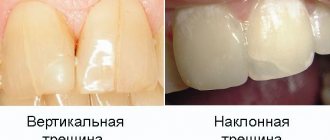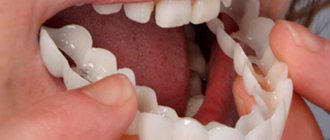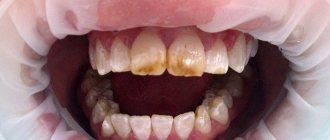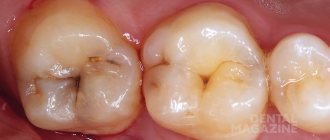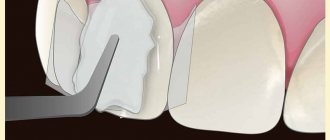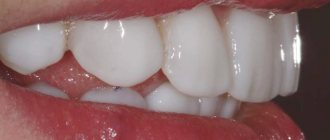What do we mean when we say “I want beautiful teeth”? In the world of ordinary things, “beautiful” most often means “noticeable, eye-catching.”
When we buy beautiful things, we expect that we will be able to attract the gaze of others, but with beautifully made teeth it is different. Beautiful teeth make the face attractive, if they are not obvious. Only you and the dentist know the secret to a renewed smile.
How to achieve such “inconspicuous beauty”?
Making a tooth both beautiful and inconspicuous means skillfully choosing the shape, surface relief and color. In this case, the restoration made will organically fit into the dentition, making the renewed smile beautiful and harmonious.
The main reason why a new tooth or restored part differs from natural teeth is a difference in color.
The fact is that we see objects and determine their color by the spectrum of light that they reflect. The path that light travels depends on the shape of the surface and the internal structure of the tooth.
The surface of a natural tooth has a complex macro- and micro-relief, and the internal structure is not uniform. Manufacturers of dental materials take into account the structural features of natural teeth and offer dentists and dental technicians materials that imitate the properties of enamel and dentin, of varying transparency and shades.
The layer-by-layer application of such materials allows you to create restorations that are as similar in structure to natural teeth and indistinguishable from them in color.
Installation of veneers
Have you heard about thin overlays that create the effect of a Hollywood smile? This is the merit of veneers. They are made of ceramic or porcelain, have high aesthetic values, look natural in the mouth and do not cause discomfort after installation. It would seem an ideal option for the front teeth. But there are still some disadvantages - high cost and the need to grind teeth. By the way, veneers can be fixed not only to the entire dentition, but also exclusively to problem areas. With their help, you can disguise chips and cracks, uneven shade of enamel and other aesthetic imperfections.
Is it so easy to put an invisible filling on a front tooth?
If the tooth is not very badly damaged, you will be offered to restore it with a filling. Aesthetic restorations made in one visit to a dentist are called “direct”.
The procedure for restoring a chipped part of a tooth seems simple, but it is not: the tooth is unevenly colored - it is darker at the gums, and almost transparent at the cutting edge. It will surprise you to know that teeth contain colors ranging from pink to blue, but the main shades are yellow, brown and gray.
Only with practice does a dentist develop an intuitive understanding of the sequence and which shades to use when layer-by-layer restoration of a particular tooth.
If you are interested, watch a video about how aesthetic restoration of the front teeth is done using Enamel plus material.
How to restore a broken tooth?
What to do if a tooth is broken in half vertically?
If the wall of a tooth is broken, the dentist tries to save one of the roots if there is a fracture of a molar that has several processes. To do this, root canal treatment is performed and removal of the appendage, which cannot be saved. Next, a crown is installed in place of the broken tooth wall.
What to do if a tooth is half broken?
If a tooth is broken in half and the chip is horizontal, the doctor evaluates the condition of the tooth and root system. A broken tooth can be repaired using composite resin for minor chips or removed for significant decay. After removing the unit, the dentist prescribes an implantation procedure with the installation of a pin.
What to do if a tooth breaks but the root remains?
If a tooth is broken and the root remains in the gum, based on x-ray data, a decision is made to preserve or remove the root.
When removing the root, the dentist offers two options for restoring the unit:
- dental implantation with the installation of a titanium pin;
- installation of adhesive bridges under a broken tooth with micro-locks on the back walls of supporting teeth.
If the size of the preserved stump is at least 3 mm, and the thickness of the remaining tooth walls is at least 1 mm, restoration is carried out using:
- filling and covering with a crown to restore the anatomical structure;
- restorations by implanting a fiberglass pin, filling and installing a crown;
- stump inlay covered with a crown.
What can you do if your front tooth is broken?
If the front tooth is broken in half, in the presence of a base, the doctor performs a build-up that will not only restore the functionality of the unit, but also restore the aesthetic appearance of the smile.
This restoration method is only possible when the broken front tooth is not affected by caries. In other cases, prosthetics are prescribed. Ask us your question DIRECTLY!
+7
DECIDE! They will definitely help you here!
What to do if your front tooth is broken at the root?
If a front tooth is broken at the root, the dentist always uses the most gentle techniques possible and tries to save the tooth if possible.
When is a tooth and root removed?
A broken wisdom tooth and a broken back tooth that is not involved in chewing processes are subject to removal. Doctors recommend removing a broken tooth if part of the hard tissue and root system is damaged, there are pronounced putrefactive processes and there is no possibility of restoring the tooth. The root subject to inflammatory and putrefactive processes, as well as the broken root of the front and chewing tooth, which cannot be restored, must be removed. The procedure is carried out using ultrasound after opening the gums. In difficult cases, the root is divided into several parts and then removed. After removing the broken tooth, a crown is installed.
Prevention
To prevent tooth fracture, specialists at the Partner-Med dental clinic recommend following the following prevention methods:
- undergo an annual dental examination;
- promptly treat caries and other dental diseases;
- Healthy food;
- replenish calcium deficiency with a course of vitamin-mineral complex;
- brush your teeth twice a day;
- After eating baked goods and sweets, rinse your mouth with clean water.
A broken tooth is a problem that anyone can face. Dentists at the Partner-Med clinic will help you choose the most gentle option for treating and restoring a broken tooth.
Request a call back or dial our number!
+7
This phone call does not obligate you to anything. Just give us a chance and we will help you!
Just pick up the phone and call us!
+7
We will definitely make you an offer that you cannot refuse!
Features of aesthetic restoration of pulpless teeth
Some patients experience darker teeth after nerve removal.
To prevent a “dead” tooth from standing out among the “living” ones, the doctor can veneer the visible part with filling material. To do this, the top layer of enamel is removed and replaced with a lighter composite material. This is a fast and relatively inexpensive method of aesthetic restoration.
Despite the fact that modern filling materials make it possible to restore a tooth “without anyone noticing,” over time, by absorbing the dyes contained in food, composite restorations become visible and have to be replaced.
Dental restoration options
The clinic can provide all types of dental restoration services.:
- Artistic restoration using advanced filling materials.
- Restoration of a pulpless (dead) tooth, if the root canals are treated correctly. Pins and crowns are used.
- Microprosthetics: veneers, onlays, inlays.
- Restoration of the coronal part after implantation: fixation of the crown to the implant.
What to do if there are several fillings on a tooth and you are tired of changing them
If you are tired of changing fillings, but want your tooth to always look “like new,” the best solution would be to install:
- ceramic veneer if the tooth is “alive”
- a ceramic crown if the tooth is pulpless
Aesthetic restoration of teeth with veneers and crowns are classified as “indirect” restorations, since they must be prepared in a dental laboratory before installation. Unlike “direct” restorations made from filling material, ceramic crowns and veneers will not change their color over time and will always look “like new.”
The ceramics from which crowns and veneers are made are close in optical properties to the enamel of natural teeth, so talented dental technicians manage to create teeth that are indistinguishable from natural ones. But in such dental restoration a new level of complexity appears: how to make sure that a dental technician who does not see the patient understands what color a veneer or crown needs to be made?
Artistic restoration of teeth
One of the most common methods is to resort to artistic dental restoration. This technique is fast and effective. A patient comes to the doctor with a problem and leaves with a “new” tooth. The procedure is carried out directly in the human oral cavity. During extensions, various composite compositions are used. The main advantage is naturalness and naturalness, the effect is simply amazing. It is difficult to recognize that the edge of the tooth is made of artificial material. In order for a tooth to last a long time, you need to follow a number of rules and protect the tooth from hard foods.
Teeth colors
This is where the color scale comes to the rescue, in which the teeth are divided into groups depending on the shades and their intensity.
It would seem that it would be difficult, given a scale, to find the desired color match. However, the choice is not as obvious as it might seem. Any surrounding colors, especially bright ones, from the patient’s makeup to the color of furniture and walls, disrupt the perception of shades.
The perception of colors is purely individual, and also deteriorates with age, so often when choosing a color, the doctor asks the opinion of the assistant and his colleagues. Lighting plays an important role in determining color (it can be artificial, natural or mixed).
Since the veneer and crown are placed on a ground tooth, it is necessary to predict what color this combination will produce.
Composite restoration
Restoration of chipped front teeth is carried out using a composite material. The dentist selects a composite filling identical in color to the natural shade of the tooth and builds up (fills) the missing part, making the smile as aesthetically attractive as before. This type of defect elimination is the most common and highly effective. Also, the reasonable price makes it accessible to every person.
Restoring anterior teeth with composite materials is possible:
— for small defect areas;
— in case of mechanical damage;
- with focal destruction by caries.
This method of restoration is in many ways superior to traditional filling, as it guarantees not only functionality, but also allows the restoration of damaged tissue (enamel, dentin) and the aesthetics of the smile. Composite restoration guarantees the original color, transparency and shape. Thanks to this, the restored tooth becomes absolutely identical to the natural one.
Restoration with composites can be indirect or direct. The first is carried out in special dental clinics, where all the necessary composite blanks are prepared for the client. The second is the application of a composite material directly to the surface (filling).
The procedure has many advantages, one of the main ones being the short session time and durability.
Why a new tooth may be noticeable
It happens that when choosing a color among the reference teeth, you can find a surprisingly suitable one. The laboratory makes the restoration in accordance with the specified color, but it looks like a “stain” in the dentition. Most often this happens if the tooth is restored with a metal-ceramic crown, and the neighboring teeth are “alive”.
Above we talked only about ceramic veneers and crowns, but it happens that in order to reduce the cost of prosthetics, the patient chooses metal-ceramic crowns, the aesthetic properties of which differ from all-ceramic ones not for the better.
The metal from which the crown frame is made does not allow light to pass through at all, and the dental technician, by combining paints and shades, tries to create a feeling of depth and transparency.
The task of “matching the color” is simplified if you choose ceramics (lithium disilicate) or zirconium dioxide lined with ceramics for the production of restorations. These materials transmit light well, but there are difficulties with color selection in this case:
- reference teeth colors in the clinic and laboratory may not match
- During the manufacturing process, after firing, ceramics may change color slightly
- ceramic masses may vary in color depending on the batch
- Even an experienced dental technician is not always able to select the combination of ceramic masses necessary to obtain the desired color
technique of layer-by-layer application of Noritake ceramic mass
It is precisely the difficulties of production that explain why, after trying on crowns and veneers, they often have to be returned to the dental laboratory for revision.
When is dental restoration required?
Indications:
- Presence of caries.
- Aesthetic defects of the dentition: chips, cracks, darkening.
- Old fillings that are noticeable and stand out when you smile.
- Presence of large interdental spaces.
- Non-carious lesions: fluorosis, enamel hypoplasia, enamel necrosis and others.
- Minor crooked teeth that can be corrected without installing braces.
Restoring half a tooth
If the patient’s tooth is destroyed by almost half, the dentist performs cosmetic restoration. Its main task is to restore the aesthetic side of a smile. The main advantages of such a renewal:
1. No pain. If the patient experiences discomfort, anesthesia may be used.
2. Restoration using restoration is much cheaper than implantation.
3. Thanks to gentle materials and working techniques, other fabrics are not damaged.
Front teeth augmentation is a highly effective method. It solves several problems at once: it makes the extended teeth as natural as possible, and allows the patient to lead a normal lifestyle (in terms of nutrition).
The extension of half an incisor has no analogues in terms of restoration. Its advantages include:
1. Complete preservation of tissues.
2. Restoration of color and shape.
3. Guarantees normal functionality.
4. Natural appearance.
5. Strength and durability.
6. Short duration of the dentist’s work (the defect is eliminated in 1 session).
For reconstruction, the doctor uses pure raw materials, which are environmentally friendly and do not have any negative effect on the body.
